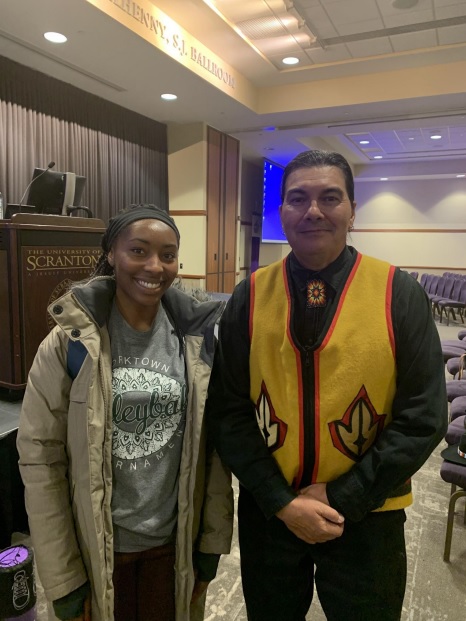Guest Speaker Curtis Zunigha Comes to Scranton

By Victoria Scruse – Staff Writer
On November 17, The University of Scranton welcomed Curtis Zunigha, co-director and co-founder of the Lenape Center in New York.
In his public keynote lecture on ”Forced Removal of the Lenape People: History and Homecoming,” at the University of Scranton, he shared the story of the Lenape people through explaining the hardships, challenges, and most of all the beauty of their culture.
Zunigha is third generation Lenape and a United States Air Force Veteran. He also worked and served for the Delaware Tribe of Indians and served on the Indian Oklahoma Affairs.
As he began his presentation, he welcomed the audience and thanked everyone for inviting him back into the land that was once for the Lenape people.
Zunigha began the story of the Lenape people through emphasizing their rich history in the area.
“There are many voices of the Lenape people and indigenous people all around here,” Zunigha said.
Zuingha displayed maps before and after the forced removal of the Lenape people and mention historic events that transpired. He explained the relationship between the Europeans and the Lenape people in which the Europeans gave the Lenape people useful tools they saw as gifts. Thus, allowing the Europeans to share the land that was given to all of humankind from the creator.
Unbeknownst to the Lenape people, European colonies would take over their land and simultaneously force the Lenape people apart.
The separation of the Lenape people later resulted to some forcefully or willingly convert to Christianity. The Lenape children along with other Native Americans attended catholic institutions where their identity and culture were stripped away. These conversions were largely due to the efforts of William Penn, founder of the Pennsylvania colony.
A large reason the Lenape people trusted William Penn is because he was a quaker. Quakerism and the Lenape culture share similar lifestyle values.
Nevertheless, the Lenape people strived to preserve their culture with many gatherings. This in turn strengthened their identity, language and obligation to recognize the sacrifice of elders.
Zinghua later explains how even after the forced removal of the Lenape people, those who identify as Native Americans were still targeted.
An example of this practice is the Paxton Boys. This group, who were predominantly were white men, would murder Native Americans, regardless of whether they converted to Christianity.
The Lenape people were deeply spiritual and well known for their oratory and egalitarian lifestyle. They believed that the creator had given them the earth and everything within the earth was their relative.
Zuingha also presented on the value of women to the Lenape people.
In their community, Zuingha mentions how females were known to have a high status and never subordinate to men.
“Women were the backbone of our society,” Zuingha said.
This ideology derives from them recognizing the female spirit related to the moon since 28 days the moon goes through can be related to 28 days of the menstrual cycle.
Before the presentation came to an end, two specific questions were asked: How should we acknowledge the land of the Lenape People? And what are your views of those who reenact your culture?
Zuingha’s response was if you’re going to acknowledge the land you have to acknowledge the people.
At the conclusion of the keynote lecture, Zinghua said thank you in his native language and says he looks forward to future events to be held by the University of Scranton.
